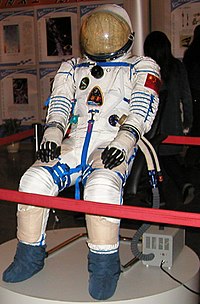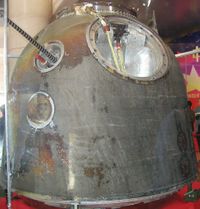Shenzhou 5
| Mission emblem | |||||||
|---|---|---|---|---|---|---|---|

|
|||||||
| Mission dates | |||||||
| Mission: | Shenzhou 5 | ||||||
| COSPAR-ID : | 2003-045A | ||||||
| Spacecraft: | Shenzhou | ||||||
| Dimensions: | 7790 kg | ||||||
| Launcher: | Long march 2F | ||||||
| Crew: | 1 | ||||||
| Begin: | October 15, 2003, 01:00 UTC | ||||||
| Starting place: | Jiuquan | ||||||
| Landing: | October 15, 2003, 10:23 PM UTC | ||||||
| Landing place: | Inner Mongolia, 41 ° 18 'N, 111 ° 24' E | ||||||
| Flight duration: | 21 h 23 min | ||||||
| Earth orbits: | 14th | ||||||
| Rotation time : | 91.2 min | ||||||
| Orbit inclination : | 42.4 ° | ||||||
| Apogee : | 336 km | ||||||
| Perigee : | 332 km | ||||||
| ◄ Before / After ► | |||||||
|
|||||||
Shenzhou 5 was the People's Republic of China's first manned space mission . The Shenzhou spaceship with the taikonaut Yang Liwei was put into orbit on October 15, 2003 and landed in Inner Mongolia after 14 orbits and around 21 hours of flight time .
Mission overview
Shenzhou 5 was launched on October 15, 2003 at 9:00 a.m. local time (3:00 a.m. CEST ) from the Jiuquan Cosmodrome in Inner Mongolia Autonomous Region in northern China with a Long March 2F launch vehicle . This version of the rocket was specially developed for manned flights. At 09:10 local time (03:10 CEST) the target orbit was reached at an altitude of 343 km and the 38-year-old fighter pilot Yang Liwei became the first Taikonaut in the People's Republic of China . This made China the third nation - after the Soviet Union and the USA - that is able to bring people into space on its own. The People's Republic of China's manned space program was only launched in 1992 .
Neither the take-off nor the landing were broadcast live on television, which is largely explained by the government's fear of a catastrophe and the associated damage to reputation abroad. However, the times of take-off and landing were announced in advance and the Chinese television broadcaster China Central Television reported a few minutes after the events. However, this behavior is strongly reminiscent of the secrecy of the Soviet Union and the USA during the space race in the 1960s.
In total, Shenzhou 5 orbited the earth 14 times at an altitude of 343 kilometers and landed 21 hours and 23 minutes after takeoff. The spacecraft entered the atmosphere on October 16, 2003 at 6:04 a.m. local time (UTC: October 15, 2003, 10:04 p.m.). According to government information, the parachute deployed as planned and the capsule landed at 06:28 (22:28 UTC) in Inner Mongolia, just 4.8 km from the planned landing site.
Shenzhou 5's orbital module remained in orbit. Up until March 16, 2004, it was mainly used for scientific experiments. On May 30, 2004, it entered the earth's atmosphere and burned up.
Hard landing
Many pictures taken shortly after landing show Yang Liwei with an injured lower lip. Hard landing rumors were circulating in China, likely spread by staff at the landing site. In addition, Colonel Yang spoke of strong vibrations 120 seconds after the start, which he described as "very uncomfortable". As a consequence, the design of the rocket for Shenzhou 6 was revised. Under the direction of Zhang Bainan , chief designer of the Shenzhou spaceships at the Chinese Academy of Space Technology since January 2004 , the vibration damping in the cabin interior was reinforced and improved shock absorbers were installed.
Political Impact
The launch of Shenzhou 5 got far more coverage in the Chinese media than any other event at the time. While the Chinese celebrated the event as a triumph for Chinese science and technology, the Western media highlighted the fact that Yang Liwei waved the United Nations flag in addition to the Chinese flag . Overall, China's first manned flight into space received much praise from all over the world.
To avoid abuse, the Chinese Astronaut Education Center and the Chinese Academy of Space Technology jointly acquired the first photo of Yang Liwei after his return from the National Agency for Industry and Commerce, and the characters for "Yang Liwei" and "Shenzhou 5" as a trademark for Enter all 45 protectable product and service categories. Any attempt to offer Yang Liwei schnapps or Shenzhou 5 trips would be punishable.
See also
Web links
- Mission overview on spacefacts.de
- Countdown to the Launch of Shenzhou-5 in the Encyclopedia Astronautica (English)
Individual evidence
- ↑ Harro Zimmer: Shenzou OM decayed (English)
- ↑ Yang Liwei shortly after landing. (No longer available online.) Archived from the original on June 25, 2008 ; Retrieved June 8, 2008 .
- ↑ 神 七 飞船 总设计师 是 张柏楠: 在 追求 中 圆梦. In: news.hit.edu.cn. September 19, 2008, accessed January 3, 2020 (Chinese).
- ↑ 我国 首位 宇航员 杨利伟 出舱 肖像 申请 商标. In: news.sina.com.cn. October 31, 2003, accessed August 19, 2019 (Chinese).



